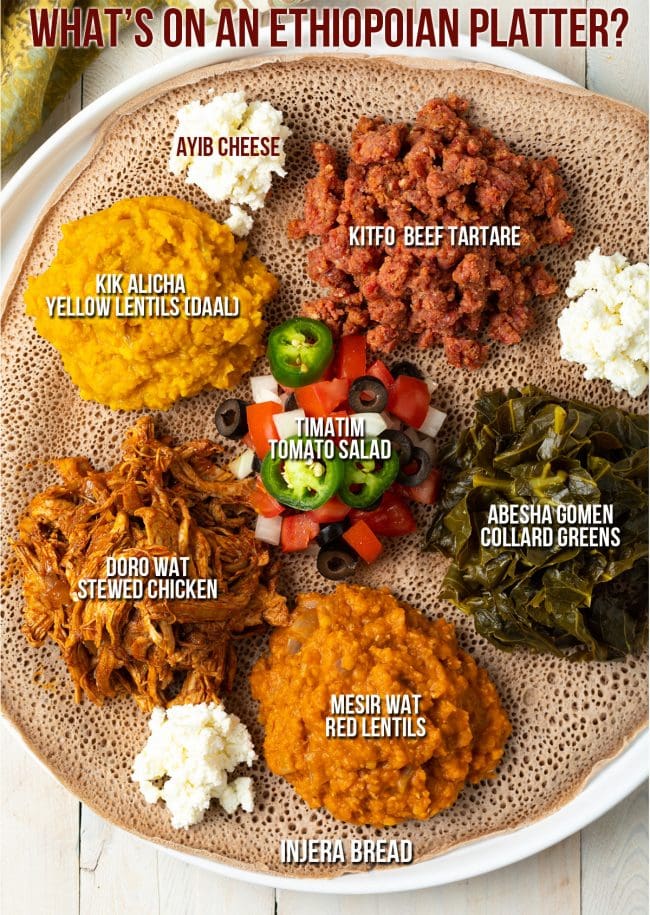Why We Love This Injera Bread Recipe
Several major American cities have large Ethiopian populations with amazing restaurants and markets throughout. Washington D.C., New York, Chicago, Atlanta, and Dallas are among the largest. When we visit family in Dallas, we always gorge ourselves on Ethiopian recipes because we know we may not enjoy this exciting and complex cuisine again for a long time. That is, unless I decide to make it at home. The staple that you need to know how to make to have delicious Ethiopian food at home is Injera, aka Ethiopian flatbread. This flatbread is always paired with other dishes to soak up the saucy meats, veggies and beans that it accompanies. This injera recipe is easy to make and super tasty! It is slightly tangy because of the sourdough. This flavor makes it perfect to have with all of the bold flavors of Ethiopian cuisine!
Ethiopian Recipes Often Found At Restaurants
A classic Ethiopian platter that you receive in a restaurant, is full of possibilities. There are so many bold and intriguing Ethiopian recipes it’s a little hard to nail it down the best. I can tell you, that a family-size Ethiopian “Queen’s Platter” usually consists of:
1-2 meat stews, made of chicken, beef, or lamb (Often shredded, chopped, or even serve raw like tartare.) 1-2 lentil/legume dishes, such as Misir Wat 1-2 cooked vegetables, including mixed vegetable stews and collard greens 1 raw vegetable dish, usually simple lettuce or tomato-based salad, often with raw spicy chiles and Ayib, fresh Ethiopian cheese
EASY Injera Recipe (Ethiopian Bread)
As we don’t have Ethiopian markets in Asheville, NC, my Ethiopian recipes have had to be tweaked quite a bit. I made quite a few adjustments to the Injera Bread Recipe to make it easier for home-cooks to not only find the ingredients but, also make it quickly. These sourdough crepes are traditionally made with teff flour and fermented for several days before cooking. With our busy schedule, I don’t start anything 3-5 days before I plan to eat it, so this had to be addressed. After several test runs, I ended up using a mix of standard all-purpose flour and buckwheat flour for texture and color. Then added a hefty dose of club soda and vinegar to create the fermented sourdough flavor. The results were fantastic! Our Easy Ethiopian Bread is not only quick and easy to make in any nonstick skillet, but it’s also tender, rollable, and undoubtedly sour… With absolutely no wait time.
Ingredients for Sourdough Crepes
You can find all these ingredients at any national grocery chain…
All-purpose Flour – to make the sourdough crepes soft and pliable Buckwheat Flour – for color and texture Baking Soda – for light air bubbles Salt – for flavor Club Soda – also to create the bubbly texture Vinegar – to create the fermented sour taste Oil – for cooking
How to Make Injera
Injera at Ethiopian restaurants is made as large pizza-sized circular crepes. At home, you can make it in any good nonstick skillet you have available.
Make a Divine Feast Fit for Royalty!
Ethiopian “Queen” Platters are a great idea for your adventurous dinner guest’s menu. There’s nothing like sitting around a large colorful platter of exotic dishes, scooping them up with your hands. Oh, the memories you will make! Serve fresh-made Injera Bread with…
Chicken Doro Wat (Doro Wot) (a chicken stew made in the slow cooker) Kitfo Ethiopian Beef Tartare or Tere Siga (minced raw meat) Mesir Wat Red Lentil Stew Ayib Cheese Yellow Peas like Daal Collards or other wilted greens (Gomen) Tomato Salad if you like. Smeared with Niter Kibbeh (a spiced clarified butter) Fenugreek Stew by Eat Smarter
Most of these dishes can be made ahead of time if needed. (PS, the links to yellow peas and collards aren’t technically Ethiopian recipes, but they are similar and VERY delicious!)
How long does this recipe last?
If you store Injera in the fridge, it will stay fresh for up to a week. If you store it at room temperature, it will stay fresh for only a couple of days.
Can I freeze this bread?
Yes, this bread can be stored in the freezer for up to 3 months. It’s easiest to pull apart if you separate each piece with wax paper before thoroughly wrapping it in plastic, or placing in large freezer bags. Keeping it in the freezer too long will result in a textural change. Thaw in the microwave or a warm oven, covered in a damp paper towel to soften.
What about the Teff flour?
Teff flour is the flour most commonly used in Ethiopia. It is light and naturally gluten-free, but not always easy to find. If you do find it, you can use it in this recipe in place of the all-purpose flour and buckwheat flour, 4 cups total.
What Other Side Dishes Can I Make?
There are some non-traditional ethiopian dishes you can pair with this bread which can include vegetables (like green beans, cabbage, potatoes, or carrots). You can focus this platter on a vegan-style dish, or vegetarian dish with more grains, porridge, and chickpeas rather than meats. You could even serve it alongside your favorite fruits, like mango or papaya.
Other Great Recipes
Best Simple Roti (Chapati Bread) Recipe Easy Navajo Fry Bread Recipe Croatian Lepinja Bread Recipe Apple Bread (Challah Bread Recipe) Homemade Naan Bread Recipe
Check the printable recipe card below for the nutrition information including calories, carbohydrates, protein, and calcium percentages. Share This Recipe With Friends!









